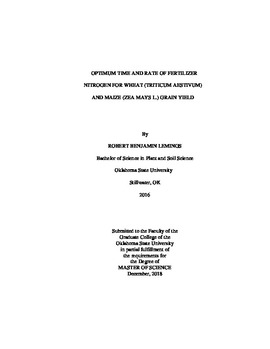| dc.contributor.advisor | Raun, William | |
| dc.contributor.author | Lemings, Robert Benjamin | |
| dc.date.accessioned | 2019-07-19T14:49:27Z | |
| dc.date.available | 2019-07-19T14:49:27Z | |
| dc.date.issued | 2018-12-01 | |
| dc.identifier.uri | https://hdl.handle.net/11244/321006 | |
| dc.description.abstract | Corn yield can be related directly to the crop's nitrogen use efficiency (NUE). A study was conducted in 2017 at two locations, Lake Carl Blackwell (LCB) and EFAW both located near Stillwater, OK. This experiment was conducted under dryland and irrigated conditions. All trials employed randomized complete block experimental designs with three replications. Nitrogen (N) applications included pre-plant, sidedress and a combination of preplant and sidedress N applied. Normalized difference vegetation index (NDVI) data was collected using an active GreenSeeker sensor to confirm N response. Results of this experiment confirmed the initial hypothesis that single N application before planting or sidedress were not as effective as split applications. Split fertilizer application delivered increased corn grain yields. To obtain maximum yields in irrigated corn, the optimum N application consisted of a sidedress rate of 134 kg N ha-1. The rainfed site showed a similar pattern requiring 134 kg N ha-1 sidedress. Low NUE for dryland corn can be attributed to the lack of appropriate water at essential times during the growing season. A pattern or trend was observed in this data suggesting the need for sidedress N applications in either dryland or irrigated environments. The crop can regulate and use N as needed, but is benefitted by having a single application to obtain maximum yield. | |
| dc.description.abstract | Wheat yields to a certain extent, are tied to the expected nitrogen use efficiency (NUE). A total of five field experiments were conducted from 2017 to 2018 all under dryland conditions. The experimental design was a completely randomized block with three replications and twelve treatments. At these five locations, nitrogen (N) was applied pre-plant, sidedress, and/or split. Normalized difference vegetation index (NDVI) data was collected using a GreenSeeker sensor to validate N response. Results of this experiment confirmed the initial hypothesis that single applications pre or sidedress were not as effective as split applications. Estimated NUE values were higher for the split N applications when compared to N applied either all preplant or all sidedress. The highest yielding treatment consisted of 67 kg N ha -1 applied pre-plant, followed by a sidedress application of 67 kg N ha -1. Low NUE for pre-plant only and for the sidedress only applications can be attributed to sporadic moisture availability at essential times during the growing season. Split N applications consistently delivered increased yields and elevated NUE. | |
| dc.format | application/pdf | |
| dc.language | en_US | |
| dc.rights | Copyright is held by the author who has granted the Oklahoma State University Library the non-exclusive right to share this material in its institutional repository. Contact Digital Library Services at lib-dls@okstate.edu or 405-744-9161 for the permission policy on the use, reproduction or distribution of this material. | |
| dc.title | Optimum Time and Rate of Fertilizer Nitrogen for Wheat (Triticum aestivum) and Maize (Zea mays L.) Grain Yield | |
| dc.contributor.committeeMember | Arnall, Daryl Brian | |
| dc.contributor.committeeMember | Zhang, Hailin | |
| osu.filename | Lemings_okstate_0664M_16049.pdf | |
| osu.accesstype | Open Access | |
| dc.description.department | Plant and Soil Sciences | |
| dc.type.genre | Thesis | |
| dc.type.material | Text | |
